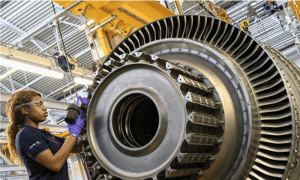Pratt & Whitney Advancing 6th Generation Military Engine Technology
PR Newswire
| 2013/09/25 | 741 words
| AVIATION WORLD NEWS | INDUSTRY / TECHNOLOGY
EAST HARTFORD, Conn., Sept. 25, 2013 /PRNewswire/ --Pratt & Whitney and the U.S. Air Force Research Laboratory (AFRL) have begun testing of Pratt & Whitney's unique, adaptive supersonic fighter engine fan rig based on a full-scale F135 development fan to advance the next generation of military fighter engine technology. The purpose of the adaptive fan rig test is to mature technologies associated with adaptive bypass flow associated with a third stream of air, which will enable efficiency improvements in long-range persistence and high thrust combat maneuvers as well as in transonic and supersonic flight conditions. Pratt & Whitney is a United Technologies Corp. (NYSE: UTX) company.
Similar to changing gears in a car or on a bicycle, changing an aircraft engine's bypass ratio allows the engine to be optimized for high thrust takeoffs, while maintaining the efficiency of a commercial airline's high bypass engine in cruise conditions. Unlike commercial airline engines which are attached to the wing, engines used in modern fighter aircraft must use smaller diameter turbofans and be embedded within the aircraft. Consequently, there is a performance tradeoff between high thrust capabilities and optimum efficiency experienced in cruise conditions. Developing a next generation variable cycle adaptive engine is therefore essential to meeting the evolving needs of the warfighter.
Modern military turbofan engines have two airstreams ? one that passes through the core of the engine, and another that bypasses the core. Development of a third stream of airflow will allow for improved fuel efficiency and cooler heat sinks which improve thermal management of the air system and reduced heat signature.
"Developing an effective adaptive fan concept is a critical step in advancing technology that will ensure next generation air dominance for our military," said Jack Hoying, program manager, Air Force Research Laboratory. "We are working closely with our industry partners to develop game-changing technologies that will truly advance the state of the art for military engines in the 21st Century."
The adaptive fan variable cycle technology will leverage and improve upon Pratt & Whitney's baseline experience in building and fielding 5th generation fighter engines ? the F119 that powers the F-22 Raptor, and the F135 powering the F-35 Lightning II, according to Bennett Croswell, president, P&W Military Engines.
"Pratt & Whitney has an innovative approach to achieving variable cycle features with a multiple flow path architecture," said Croswell. "We're building on our foundation of proven 5th generation capabilities, and we are now mastering adaptive technologies ? really expanding the boundaries of state of the art engine technology critical for the next 6th generation aircraft."
The fan rig test is being conducted in tandem with several other technology initiatives that are advancing the state of military engine technology, including the AFRL-sponsored Adaptive Engine Technology Demonstration (AETD) program, the U.S. Navy Fuel Burn Reduction (FBR) program, and other internal Pratt & Whitney advanced engine concept efforts.
The AETD program has a goal of providing a 25 percent improvement in specific fuel consumption and a 10 percent improvement in thrust levels compared to today's fifth-generation combat aircraft engines. The FBR demonstration program is focused on delivering a 5+ percent reduction in fuel burn in an F135 demonstration engine.
The adaptive fan rig tests are being conducted at the AFRL Compressor Research Facility (CRF) in Dayton, Ohio. The jointly-funded program was launched in late 2011, with tests of the adaptive fan concept taking place from August through September 2013. Following testing, the combined Pratt & Whitney and AFRL team will conduct additional processing and engine test analysis.
Pratt & Whitney is a world leader in the design, manufacture and service of aircraft engines, auxiliary and ground power units, and small turbojet propulsion products. United Technologies Corp., based in Hartford, Connecticut, is a diversified company providing high technology products and services to the building and aerospace industries. To learn more about UTC, visit the website or follow the company on Twitter: @UTC.
This press release contains forward-looking statements concerning future business opportunities. Actual results may differ materially from those projected as a result of certain risks and uncertainties, including but not limited to changes in government procurement priorities and practices, budget plans and availability of funding, and in the number of aircraft to be built; challenges in the design, development, production and support of advanced technologies; as well as other risks and uncertainties, including but not limited to those detailed from time to time in the company's Securities and Exchange Commission filings.
Matthew Bates +1-860-557-3595Int'l Mobile +1-860-371-9857 matthew.bates@pw.utc.com
SOURCE Pratt & Whitney
Similar to changing gears in a car or on a bicycle, changing an aircraft engine's bypass ratio allows the engine to be optimized for high thrust takeoffs, while maintaining the efficiency of a commercial airline's high bypass engine in cruise conditions. Unlike commercial airline engines which are attached to the wing, engines used in modern fighter aircraft must use smaller diameter turbofans and be embedded within the aircraft. Consequently, there is a performance tradeoff between high thrust capabilities and optimum efficiency experienced in cruise conditions. Developing a next generation variable cycle adaptive engine is therefore essential to meeting the evolving needs of the warfighter.
Modern military turbofan engines have two airstreams ? one that passes through the core of the engine, and another that bypasses the core. Development of a third stream of airflow will allow for improved fuel efficiency and cooler heat sinks which improve thermal management of the air system and reduced heat signature.
"Developing an effective adaptive fan concept is a critical step in advancing technology that will ensure next generation air dominance for our military," said Jack Hoying, program manager, Air Force Research Laboratory. "We are working closely with our industry partners to develop game-changing technologies that will truly advance the state of the art for military engines in the 21st Century."
The adaptive fan variable cycle technology will leverage and improve upon Pratt & Whitney's baseline experience in building and fielding 5th generation fighter engines ? the F119 that powers the F-22 Raptor, and the F135 powering the F-35 Lightning II, according to Bennett Croswell, president, P&W Military Engines.
"Pratt & Whitney has an innovative approach to achieving variable cycle features with a multiple flow path architecture," said Croswell. "We're building on our foundation of proven 5th generation capabilities, and we are now mastering adaptive technologies ? really expanding the boundaries of state of the art engine technology critical for the next 6th generation aircraft."
The fan rig test is being conducted in tandem with several other technology initiatives that are advancing the state of military engine technology, including the AFRL-sponsored Adaptive Engine Technology Demonstration (AETD) program, the U.S. Navy Fuel Burn Reduction (FBR) program, and other internal Pratt & Whitney advanced engine concept efforts.
The AETD program has a goal of providing a 25 percent improvement in specific fuel consumption and a 10 percent improvement in thrust levels compared to today's fifth-generation combat aircraft engines. The FBR demonstration program is focused on delivering a 5+ percent reduction in fuel burn in an F135 demonstration engine.
The adaptive fan rig tests are being conducted at the AFRL Compressor Research Facility (CRF) in Dayton, Ohio. The jointly-funded program was launched in late 2011, with tests of the adaptive fan concept taking place from August through September 2013. Following testing, the combined Pratt & Whitney and AFRL team will conduct additional processing and engine test analysis.
Pratt & Whitney is a world leader in the design, manufacture and service of aircraft engines, auxiliary and ground power units, and small turbojet propulsion products. United Technologies Corp., based in Hartford, Connecticut, is a diversified company providing high technology products and services to the building and aerospace industries. To learn more about UTC, visit the website or follow the company on Twitter: @UTC.
This press release contains forward-looking statements concerning future business opportunities. Actual results may differ materially from those projected as a result of certain risks and uncertainties, including but not limited to changes in government procurement priorities and practices, budget plans and availability of funding, and in the number of aircraft to be built; challenges in the design, development, production and support of advanced technologies; as well as other risks and uncertainties, including but not limited to those detailed from time to time in the company's Securities and Exchange Commission filings.
Matthew Bates +1-860-557-3595Int'l Mobile +1-860-371-9857 matthew.bates@pw.utc.com
SOURCE Pratt & Whitney
Tags :












